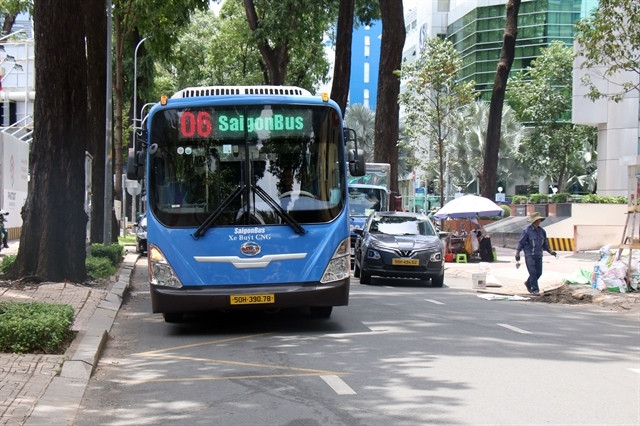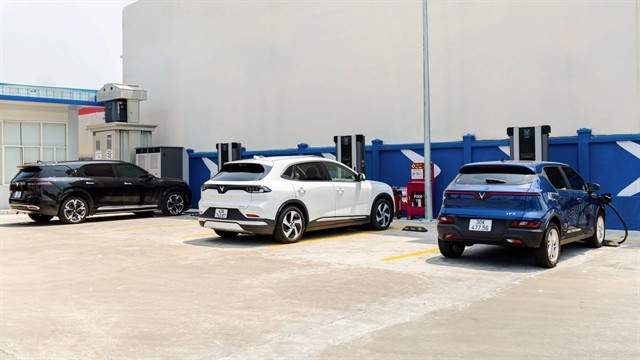 |
| A CNG bus running on road in HCM City. Việt Nam has set target that all vehicles on road will use electricity and green energy by 2050, opening significant opportunities for the development of EVs in the country. — VNA/VNS Photo Tiến Lực |
The rapid expansion of electric vehicles (EVs) has raised a pressing need for Việt Nam to develop a compatible electrical grid and charging infrastructure, with a step-by-step roadmap critical to phase out fossil-fuel vehicles.
EVs are revolutionising the global auto industry, with the trend of them becoming a popular choice for consumers looking to reduce their carbon footprint and save money on fuel costs, also taking hold in Việt Nam.
Việt Nam is accelerating in terms of the number of EVs, however, a long-term vision is needed for the country to think ahead and 'go far' with EVs in the journey towards net-zero emissions, according to Shinnosuke Ito, manager of the Environment and Energy Policy Bureau under Japan Business Federation (Keidanren).
Potential market
After the introduction of first EV models in Việt Nam, including BMW i3 in 2016 and Porsche Taycan in 2020, which generated significant curiosity and interest at that time when gasoline and diesel vehicles remained dominant, the entrance of Vietnamese car maker VinFast with the launch of VF e34 in 2021 and a strategic decision to focus exclusively on electric vehicles marked a pivotal milestone for the market in Việt Nam.
Vinfast has significantly changed the landscape of the domestic EV market.
Statistics of the Việt Nam Register showed that while the number of imported electric cars was modest, at 366 from 2020 to the end of March 2024, the number of domestically manufactured cars has jumped rapidly.
Việt Nam did not start to produce electric cars until 2021, but the numbers manufactured and assembled in the country reached 30,298 units in the period. Notably, there are electric cars at low prices, only at around VNĐ200 million (US$7,920) each.
VinFast alone has so far sold over 42,291 EVs, including cars and motorbikes, since 2021, the company’s statistics showed.
The domestic EV market is expected to be more exciting with the penetration of China’s unicorn carmaker BYD with three models, the Seal, Atto3 and the Dolphin.
BYD has recently opened the largest dealership in the north of Việt Nam in Long Biên, Hà Nội.
"BYD currently has 36 dealerships in Việt Nam and expects to increase the number to 50 by the end of this year, 70 by 2025 and 100 by 2026," Võ Minh Lực, general director of BYD Auto Việt Nam, said. However, BYD will not invest in developing its own charging stations in Việt Nam.
A recent market insight by HSBC showed that Việt Nam’s annual electrifying two-wheelers and electric cars sales could rise from less than 1 million in 2024 to over 2.5 million by 2036.
The Việt Nam Automobile Manufacturers Association forecasts that around 1 million people will own electric cars by 2028 and 3.5 million by 2040.
The market research company Business Monitor International (BMI) expects EVs sales in Việt Nam to expand by around 25.8 per cent in 2023-32 period.
Prime Minister Phạm Minh Chính at COP26 made a strong commitment that Việt Nam will achieve Net Zero by 2050.
In a bold effort to realise that carbon-neutral goal, the country has outlined roadmap to reduce emissions of the transportation sector. Accordingly, by 2050, all vehicles on road will use electricity and green energy together with the development of a compatible charging infrastructure nationwide, opening significant opportunities for the development of EVs in the country.
Infrastructure is the key
Crucially, government policies are encouraging EV production and consumption. But more investment is required in infrastructure for the EV boom to truly take shape, according to HSBC’s report.
It is reported that around 150,000 EV charging stations were installed, mostly by VinFast, in apartment buildings, shopping malls, parking lots and petrol stations, covering 63 provinces and cities across the country as of the end of 2023.
The number of EV charging stations in Việt Nam is, in fact, much higher than countries which have heavily invested in green transport such as the Netherlands which has 120,000 charging stations, France with 84,000 or Germany with 77,000, according to data of Statista.
However, the HSBC report pointed out that charging stations on highways were few and far between.
The lender estimated that Việt Nam will need US$12.3 billion investing in infrastructure to popularise EVs.
A survey by the HCM City Department of Transport late last year found that worry over difficulty in finding a charging station is one among four major reasons for hesitation in switching to EVs.
According to Patrick Morgan, Analog Devices’ vice president of automotive and energy, Việt Nam has lots of potential in the EV market. "But it is the grid and charging infrastructure that plays a decisive role in the development of EVs in Việt Nam," he said, adding that the investment must crucially meet the demand.
 |
| A charging station of VinFast in Đà Nẵng City. More investment is required in infrastructure for the EV boom to truly take shape. — VNA/VNS Photo |
Think ahead
While the current charging infrastructure has not been able to meet the demand, the rapid EV development might bring problems which need to be foreseen and addressed.
“It is impossible to jump straight to EVs. We need to go stage by stage. Maybe hybrid cars are a better option at the moment,” Ito said to Asian journalists attending the programme of Keizai Koho Centre (KKC) under the Japan Institute for Social and Economic Affairs in Tokyo in mid-July.
Reiji Takehara, KKC’s managing director, said that a number of problems must be considered in developing EVs.
"It is critical to clarify who will be in charge of developing the charging infrastructure, the Government, the carmaker or other parties, as well as the mechanisms for development and for sharing the charging infrastructure and the handling of batteries," Takehara said.
"Another important factor is how many per cent of renewable energies are used in charging," he said, adding that if fossil fuel is mainly used for charging, EVs will not be truly green as it is meant to be.
“In EV development, Việt Nam needs to look ahead to have an appropriate and realistic step-by-step roadmap,” he said.
In fact, imported EVs must now be charged at home, at dealerships or at public charging stations developed by third parties like EVIDA, Chargeplus and Việt Nam Electricity (EVN) but the number of these charging stations remains modest.
Meanwhile, VinFast does not have any plan to share its charging infrastructure with other carmakers in the next ten years.
Experts say it is necessary to have a plan for a charging network as well as common standards for charging stations. Currently, each carmaker has its own standards for charging stations.
Regulations on standards for charging stations in urban areas, residential areas, bus stations, shopping centres, hotels, offices, apartment buildings, restaurants, parking places and office buildings are also needed.
A research group from Hà Nội University of Technology said that charging stations should be connected and operated through a common system in line with the development of charging technologies in the world.
The Ministry of Science and Technology has issued 11 standards for charging stations and been developing another 18 standards regarding charging stations and relevant devices.
The ministry will also study and propose policies to encourage the investment in charging infrastructure.
The Ministry of Transport has amended regulations about national technical standards for rest stops along highways. Accordingly, rest stops must have charging facilities for EVs.
Nguyễn Thị Phương Hiền, deputy director of the Transport Development and Strategy Institute, said that the government policies should focus on developing charging infrastructure as well as the electricity network. - VNS